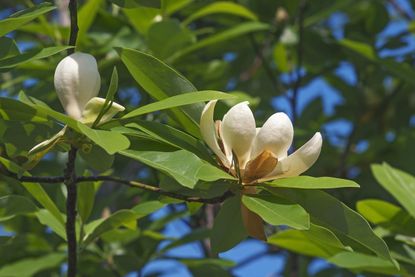Diseases Of Sweetbay Magnolia Trees – Treating A Sick Sweetbay Magnolia


Sweet bay magnolia (Magnolia virginiana) is an American native. It is generally a healthy tree. However, sometimes it is hit by disease. If you need information about sweetbay magnolia diseases and magnolia disease symptoms, or tips for treating a sick sweetbay magnolia in general, read on.
Diseases of Sweetbay Magnolia
Sweetbay magnolia is a graceful southern tree, evergreen in many regions, that is a popular ornamental tree for gardens. A wide columnar tree, it grows to a height of 40 to 60 (12-18 m.) feet tall. These are lovely garden trees, and the silver undersides of the leaves glimmer in the wind. The ivory flowers, scented with citrus, stay on the tree all summer. Generally, sweetbay magnolias are strong, vital trees. However, you should be aware of the diseases of sweetbay magnolia that might infect your trees. Treating a sick sweetbay magnolia depends on what type of problem is affecting it.
Leaf spot diseases
The most common diseases of sweetbay magnolia are leaf spot diseases, fungal or bacterial. Each has the same magnolia disease symptoms: spots on the leaves of the tree. Fungal leaf spot can be caused by the Pestalotiopsis fungus. The symptoms include circular spots with black edges and rotting centers. With Phyllosticta leaf spot in magnolia, you’ll see small black spots with white centers and dark, purplish black borders. If your magnolia shows large, irregular shops with yellow centers, it might have anthracnose, a leaf spot disorder caused by the Colletotrichum fungus. Bacterial leaf spot, caused by the Xanthomonas bacterium, produces small rotting spots with yellow halos. Algal leaf spot, from the algal spore Cephaleuros virescens, causes raised spots on the leaves. To start treating a sick sweetbay magnolia that has leaf spot, stop all overhead irrigation. This creates moist conditions in the upper leaves. Trim out all affected foliage to reduce contact with healthy foliage. Be sure to rake up and get rid of the fallen leaves.
Serious sweetbay magnolia diseases
Verticillium wilt and Phytophthora root rot are two more serious sweetbay magnolia diseases. Verticillium albo-atrum and Verticillium dahlia fungi cause verticillium wilt, an often-fatal plant disease. The fungus lives in the soil and enters through the magnolia roots. Branches may die and the weakened plant is vulnerable to other diseases. Within a year or two, the entire tree usually dies. Phytophthora root rot is another fungal disease that lives in wet soil. It attacks trees through the roots, which then become rotten. Infected magnolias grow poorly, have wilting leaves, and may die.
Gardening tips, videos, info and more delivered right to your inbox!
Sign up for the Gardening Know How newsletter today and receive a free download of our most popular eBook "How to Grow Delicious Tomatoes."

Teo Spengler has been gardening for 30 years. She is a docent at the San Francisco Botanical Garden. Her passion is trees, 250 of which she has planted on her land in France.
-
 Urban Composting Guide: How To Compost In The Middle Of The City
Urban Composting Guide: How To Compost In The Middle Of The CityUrban composting does not have to be daunting. You can compost in the city, and maybe even try some urban worm composting!
By Mary Ellen Ellis
-
 Shrub Diseases And Pests To Watch Out For
Shrub Diseases And Pests To Watch Out ForShrub diseases and pests can be challenging. Learn how to recognize and eradicate them before they can present a danger to your plants.
By Susan Albert